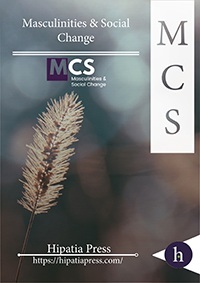“So I Won’t Go to Jail”: Year Two of a PROMUNDO-Adapted Program to Eradicate Gender-Based Violence
Keywords:
Downloads
Abstract
This paper presents evaluation results of a PROMUNDO-adapted program enacted to reduce gender-based violence among preadolescent boys. Outcomes that are examined include promoting critical thinking regarding masculinity, aggression, and violence; fostering skills necessary for effective communication, prosocial emotional expression, and non-violent conflict resolution. While quantitative findings in this small sample do not indicate statistically significant results, qualitative analyses indicate that participants were better equipped to express their emotions, particularly anger, and to resolve conflict in non-violent ways that may slow the school-to-prison pipeline.
Downloads
References
Alexander, M. (2012). The New Jim Crow: Mass incarceration in the age of colorblindness.
Google Scholar CrossrefThe New Press.
Google Scholar CrossrefAmerican Psychological Association Zero Tolerance Task Force. (2008). Are zero tolerance policies effective in the schools?: An Evidentiary Review and Recommendations. American Psychologist, 63(9):852-862. DOI: http://dx.doi.org/10.1037/0003-066X.63.9.852.
Google Scholar CrossrefAnderson, S. (2011) Men of strength clubs: 2009-2010 evaluation findings. Retrieved from http://www.mencanstoprape.org/images/stories/MCSR_2010__Evaluation.pdf.
Google Scholar CrossrefBarker, G., Ricardo, C., & Nascimento, M. (2007). Engaging men and boys in changing gender-based inequity in health: Evidence from programme interventions. Geneva: World Health Organization. Retrieved from https://www.who.int/gender/documents/Engaging_men_boys.pdf
Google Scholar CrossrefBasile, K.C., D.L. Espelage, I. Rivers, P.M. McMahon, & T.R. Simon. (2009). The theoretical and empirical links between bullying behavior and sexual violence perpetration. Aggression and Violent Behavior, 14(5):336-347. DOI: 10.1016/j.avb.2009.06.001.
Google Scholar CrossrefBoender, C., Santana, D., Santillán, D., Hardee, K., Greene, M.E., & Schuler, S. (2004). The “so what” report: A look at whether integrating a gender focus into programs makes a difference to outcomes. Washington, D.C.: Population Reference Bureau. Retrieved from https://www.igwg.org/resources/the-so-what-report-a-look-at-whether-integrating- a-gender-focus-into-programs-makes-a-difference-to-outcomes/.
Google Scholar CrossrefChristle, C.A., Jolivette, K., & Nelson, C.M. (2005). Breaking the school to prison pipeline: Identifying school risk and protective factors for youth delinquency. Exceptionality: A Special Education Journal,13(2):69-88. DOI: 10.1207/s15327035ex1302_2.
Google Scholar CrossrefCourtenay, W.H. (2000). Constructions of masculinity and their influence on men’s well-being: A theory of gender and health. Social Science and Medicine, 50:1385-1401. Retrieved from: http://citeseerx.ist.psu.edu/viewdoc/download.&rep=rep1&type=pdf DOI: 10.1.1.462.4452
Google Scholar CrossrefDeGue, S., D. DiLillo, M. Scalora. (2010). Are all perpetrators alike? Comparing risk factors for sexual coercion and aggression. Sexual Abuse: A Journal of Research and Treatment,11(4):402-426. doi: 10.1177/1079063210372140
Google Scholar CrossrefEspelage, D.L., K.C. Basile, & M.E. Hamburger. (2012). Bullying perpetration and subsequent sexual violence perpeteration among middle school students. Journal of Adolescent Health, 50(1):60-65. doi: 10.1016/j.jadohealth.2011.07.015
Google Scholar CrossrefFoley, A., Powell-Williams, T., & Davies, K. (2015). Engaging boys in eradicating gender-based violence: A pilot study of a Promundo-adapted program. Masculinities and Social Change, 4(1):26-43. DOI:10.4471/MCS.2015.59
Google Scholar CrossrefGriffith, D.M., K. Gunter & D.C. Watkins. (2012). Measuring masculinity in research on men of color: Findings and future directions. American Journal of Public Health, 102(Suppl2):S187-S194. doi: 10.2105/AJPH.2012.300715.
Google Scholar CrossrefKreinert, J. (2003). Masculinity and crime: A quantitative exploration of Messerschmidt’s hypothesis. Electronic Journal of Sociology 7:1-30. Retrieved from: http://www.soc.iastate.edu/sapp/Masculinity2.pdf.
Google Scholar CrossrefKyckelhahn, T. (2015). Justice expenditure and employment extracts, 2012 – Preliminary. Retrieved from: http://www.bjs.gov/index.cfm?ty=pbdetail&iid=5239
Google Scholar CrossrefLevtov, R.G., Barker, G., Contreras-Urbina, M., Heilman, B., & Verma, R. (2014). Pathways to gender-equitable men: Findings from the International Men and Gender Equality Survey in eight countries. Men and Masculinities. 17(5):467-501. DOI: 10.1177/1097184X14558234.
Google Scholar CrossrefLospennato, R.K. (2009). Multifaceted strategies to stop the school-to-prison pipeline. Journal of Poverty Law and Polic, 42(11-12):528-619. Retrieved from: https://www.povertylaw.org/clearinghouse/articles/multifaceted-strategies-stop-school-prison-pipeline.
Google Scholar CrossrefMesserschmidt, James W. (1993). Masculinities and crime: Critique and reconceptualization of theory: Rowan & Littlefield Publishers, Inc.
Google Scholar CrossrefNational Council on Gender. (2012). Gender norms: A key to improving life outcomes in at-risk populations. Washington, D.C.: National Council on Gender. Retrieved from: https://promundoglobal.org/resources/gender-norms-a-key-to-improving-life-outcomes-in-at-risk-populations/.
Google Scholar CrossrefPopulation Reference Bureau. (2011). Gender perspectives improve reproductive health outcomes. Washington, D.C.: Population Reference Bureau. Retrieved from: https://assets.prb.org/igwg_media/summary-report-gender-perspectives.pdf.
Google Scholar CrossrefPorter, N. (2014). The state of sentencing: Developments in policy and practice. The sentencing project research and advocacy for reform. Retrieved from: http://sentencingproject.org/doc/publications/sen_State_of_Sentencing_2014.pdf.
Google Scholar CrossrefPulerwitz, J., Barker, G., & Segundo, M. (2004). Promoting healthy relationships and HIV/STI prevention for young men: Positive findings from an intervention study in Brazil. Horizons Research Update. Washington D.C.: Population Council. Retrieved from: https://www.popcouncil.org/uploads/pdfs/horizons/brgndrnrmsru.pdf.
Google Scholar CrossrefRao Gupta, G., Whelan, D., & Allendorf, K. (2002). Integrating gender into HIV/AIDS programmes. Geneva: International Center for Research on Women. Retrieved from: https://www.who.int/gender/hiv_aids/hivaids1103.pdf.
Google Scholar CrossrefRicardo, C., Eads, M., & Barker, G. (2011). Engaging boys and young men in the prevention of sexual violence: A systematic and global review of evaluated interventions. Washington D.C.: Promundo-US. Retrieved from https://reliefweb.int/sites/reliefweb.int/files/resources/menandboys.pdf.
Google Scholar CrossrefRicardo, C. Nascimento, M., Fonseca, V., & Segundo, M. (2010). Program H and Program M: Engaging young men and empowering young women to promote gender equality and health. Washington, D.C.: Pan American Health Organization. Retrieved from: https://promundoglobal.org/resources/program-h-and-program-m-engaging-young-men-and-empowering-young-women-to-promote-gender-equality-and-health/?lang=english
Google Scholar CrossrefWald, J., & Losen, D.J. (2003). Defining and redirecting a school‐to‐prison pipeline. New Directions for Youth Development, 99:9-15. Retrieved from: https://doi.org/10.1002/yd.51.
Google Scholar CrossrefWallace, J.M., S. Goodkind, S.Wallace, & J.G. Bachman. (2008). Racial, ethnic, and gender differences in school discipline among U.S. high school students: 1991-2005. Negro Educational Review. 2008 59(1-2):47-62. Retrieved from: http://www.ncbi.nlm.nih.gov/pubmed/19430541
Google Scholar CrossrefWestern, Bruce. (2007). Punishment and inequality in America. Sage Publications.
Google Scholar CrossrefDownloads
Published
Almetric
Dimensions
How to Cite
Issue
Section
License
All articles are published under Creative Commons copyright (CC BY). Authors hold the copyright and retain publishing rights without restrictions, but authors allow anyone to download, reuse, reprint, modify, distribute, and/or copy articles as the original source is cited.















